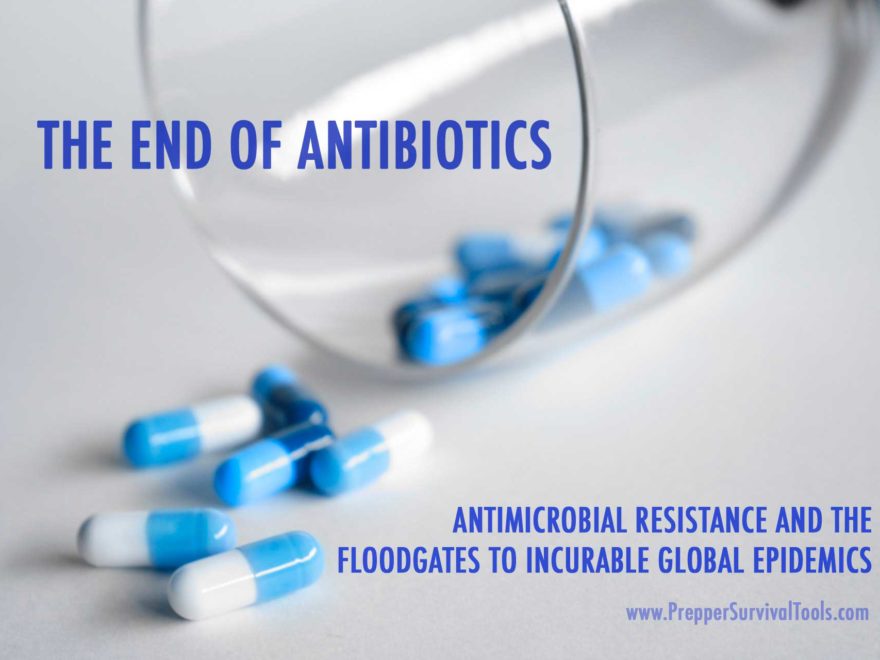While it is not on the mind of the average global citizen, scientists and governments around the world have acknowledged that they have come face to face with impending catastrophe.
“Every antibiotic currently in use is a derivative of one discovered between 1900 and 1984, and the rapid increase of antibiotic resistance has lead to infections that are untreatable.” according to the a release from the IDSA or Infectious Diseases Society of America.
“Each year in the United States, at least 2 million people become infected with bacteria that are resistant to antibiotics and at least 23,000 people die each year as a direct result of these infections.” this is according to the United States CDC or Centers for Disease Control and Prevention.
Yes, the world is running out of new antibiotics to fight diseases. In fact, cases of incurable diseases are already cropping up around the world. It has been called by the BBC as an antibiotic apocalypse. This issue has now become one of the world’s biggest challenges in public health, and it’s now becoming worse… a lot worse.

What exactly is antibiotic resistance?
Antibiotic resistance, or microbial antibiotic resistance, is the increased immunity of bacteria to the antibiotics we administer to get rid of them. For examples, the heavy use of antibiotics isoniazid and rifampicin has allowed tuberculosis (caused by the bacterium Mycobacterium tuberculosis) has been largely eradicated in most highly-developed western countries and more or less control it in much of the world. But with the widespread use of isoniazid and rifampicin to cure tuberculosis, there eventually were a few strains of the tuberculosis bacterium with the carriers (infected people) that survived the antibiotic treated. These hardier strains of tuberculosis were spread to a ‘second generation’ of carriers who were also treated with the same kind antibiotics. Because that these tuberculosis bacterium were already hardier to begin with, even hardier tuberculosis strains are more likely to survive or resist the antibiotics isoniazid and rifampicin when administered to this second generation of carrier.
This self-reinforcing vicious cycle of more resistant strains microbes with each generation of carriers will continue until strains will develop total immunity or resistance to the antibiotic, in this example tuberculosis bacterium unaffected by isoniazid and rifampicin.
And this example, it isn’t just far off thinking. Tuberculosis resistant to isoniazid and rifampicin has already emerged in some parts of Papua New Guinea, India, China and Russia.
Now this problem has spread all over the world over for many kinds of disease. And, as antibiotics become cheaper and doctors continue to prescribe copious amounts antibiotics as trained in medical school, the problem is just getting worse year by year.
What is causing antibiotic resistance?
What makes it worse, is the main culprit, or perhaps what has accelerated this process far beyond normal, is our own overuse of antibiotics. The main culprit are doctors themselves. For decades, doctors have indiscriminately been prescribing antibiotics to patients. Because it is hard to distinguish viral infections (which can’t be cured by antibiotics) and bacterial infections (which can) doctors, who will almost most likely err on the safe side, prescribe antibiotics. Even when it seems apparent that their patients will likely recover from an infection on their own, they might still prescribe a course of antibiotics just to be sure. This has resulted in massive, unnecessary doses of antibiotics, flooding into the human populations. Overtime, this antibiotic strains of various bacterial infections emerge, as hardier and hardier strains get the chance to spread from person to person.
Our own doctors prescribing way too much antibiotics is not the only issue. Another major source of antibiotics is our food. As global populations swelled Post-World War 2, industrial rearing of livestock were developed to increase profits and meet the growing demand for affordable meat. However, these industrial meat rearing keep livestock in horrendous conditions, packed side by side with hardly enough space to move and in close constant contact with each others filth. Without antibiotics, disease can quickly spread and wipe out entire flocks or herds in a matter of days. Farmers turned to antibiotics to keep livestock alive and from disease from decimating the stock.
As an unintended side effect, it was also discovered that antibiotics often made animal fatter (due to effects of antibiotics on the livestocks gut microbiome). This made the copious use of antibiotics livestock as growth promoters. While jurisdictions like the European Union have banned the use of antibiotics as growth promoters. This cannot be said true of all regions in the world.
Some countries, such as Russia, China and India, continue to pump their livestock full of antibiotics, both to keep their animals alive in the horrid conditions of the industrialized meat industry, and as growth promoters.
Antibiotic resistance is a reality. Cases of bacterial infections resistant to all known antibiotics are on the rise. It is just a matter of time before the right kind of antibiotic resistant bacteria breaks out.

Scenario: What if an antibiotic global epidemic breaks out?
With the millions of travelers crisscrossing the globe daily, the potential of a SHTF fan scenario due to pandemics is real. One plane full of passengers transiting a major airport have the potential to unintendedly (or intendedly!) spread a disease to most major cities in world. From the the major cities, an untreatable epidemic can spread virtually to any major population center in the world.
What would a global epidemic be like?
In the study of viruses, or virology, it has been observed that some virus are more virulent, which is they are known to spread fast and kill fast. A virus should also be highly infectious – it should be able to spread easily from one person to another. Thus, the “perfect” candidate will most likely be a virus that has three main qualities:
- it should an airborne disease, meaning it should be spreadable by air
- have a long incubation period, meaning it can go undetected for a few weeks before symptoms show, and it will not kill the infected at once
- it will have a high mortality rate, to cause the most damage to society
Viruses tend to become less virulent or deadly as they spread. As a virus spreads from person to person, the strains of the virus which killed their carriers (infected persons or hosts) faster spread less than the strains of the virus which let their victims stay alive (and infect others) longer. This was seen in other historical pandemics, like the Spanish Flu or Small Pox.
Anthrax, another super flu, or a killer drug-resistant tuberculosis seem likely candidates. They could occur “naturally” from antibiotic resistance disease hotspots. Perhaps it can even a weaponized virus intentionally spread by terrorists.
How will governments react to global epidemics?
We have already seen samples on how governments will react with recent epidemics like the Avian Bird Flu. You can expect stricter immigration controls. Travellers from infected countries may have to undergo quarantines at the ports of entry, such as airport. In the name of “national security”, countries can impose regulations stricter than they would during normal times. Imagine the United States totally banning all forms of travel from countries like China, or regions like West Africa. This may work for some time, but when too the outbreak happens in too many countries,
International help from bodies the the United Nations World Health Organization may rush to help epidemic-stricken areas. But bogged by its internal bureaucracy and limited by its own capabilities, it may not be able to handle massive epidemics across the world.
Possible scenario: The Chinese Superbug
A city in the northern China during suddenly has a massive outbreak of incurable flu during winter. News about the outbreak is suppressed or downplayed keeping the rest of the country and the international community in the dark about the outbreak. Despite the best efforts to keep the infected towns and cities under quarantine, lot of carriers of the flu will be able to slip past controls and spread to other cities in China. Alarm is raised when it has spread to too many cities. Many carriers from within China will travel abroad. Major airports will become hotspots for the virus. Once it the virus is spread within any major airport, it will easily to spread across the globe.
An infected person from one of China’s inland megacities lands in Doha airport. Hundreds of international flights leave Doha a day to all corners of the globe.
In a matter of days, the virus would have spread to many major cities in the world. By the time international alarms are raised the virus may be too wide-spread to control. This will weaken international efforts to get the superbug under control.
Why China?
Why China? Aside from the massive doses of antibiotics that enters into the food supply from the meat industry, Chinese medical practices are known for their doctors prescribing antibiotic IV drips at the slightest hint of any microbial infection. Patients young and old lined up for antibiotic IV drips are an ubiquitous sight in Chinese hospitals.
The Chinese government has a penchant for censoring negative news. News that is potentially destablizing or can cause panic, like an incurable epidemics, is very likely to be censored. This will worsen the problem as this will not warn other people of the infections allowing it to spread all over the country and across international borders.
The country is vast an population dense giving the epidemic a large population to take root in. China also has the world’s largest internal migrations twice a year – during the Spring Festival and the week-long national holidays when workers from the city make their trips to their hometowns – or vacations abroad. With vast numbers of people traveling in and out of the country is bound to spread the virus internationally.
Why will it likely start during winter?
It is during winters (or very hot summers) that people tend to spend much more time indoors. A single sick school child can spread the flu to all this classmates crammed in a classroom with them the whole day. This trend has already been seen in colder cities where the onset of winter brings in the “flu season”.
What can you do to prepare for an antibiotic resistant global epidemics?
The urban prepper will be at a disadvantage to the rural prepper since epidemics will spread much faster in the cities where there is higher population density. In this case, bugging out instead of bugging can save you from contact with the virus.
Be sure you have your bug-out bags and your bug out plans ready. Be prepared to act quickly at the first news of a spreading epidemic. In the name of national security, it is possible that the military is mobilized to lock down the city, trapping you inside.
Having stockpiles of food and weapons to defend them will become important. Very quickly population dense areas descend into chaos. As law and order breaks down, looters will look for their targets.
Even though the epidemic is an incurable one, people will clear off most antibiotics of shelves, as was seen in previous epidemics. You might want to keep a stock of antibiotics aside from the usual stockpiles of goods you have. You may want to consider stockpiling post-apocalyptic currencies.
Suggested Further reading:
Part of the series of The End of Antibiotics is our article on The End of Topsoil. Topsoil is one of the most undervalued non-renewable resource one the planet, and most people don’t even know it. The United National Food and Agricultural Organization estimate that we just have 60 years before all the world’s agricultural topsoil is practically gone. As you can imagine, it won’t take all the topsoil in the world to disappear before world wide anarchy breaks out.
If an untreatable global epidemic hits you’ll have to stay far away from the cities to escape the chaos. However you can NOT rely on planting the same vegetables you see in your supermarket. It is best to grow what are called “heirloom vegetables”: The Heirloom Seed Encyclopedia for Preppers and Survivalists


